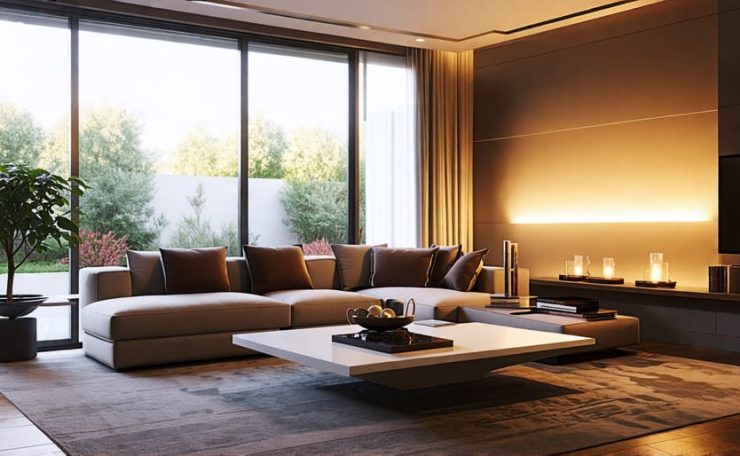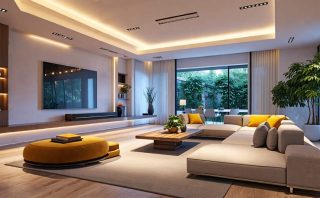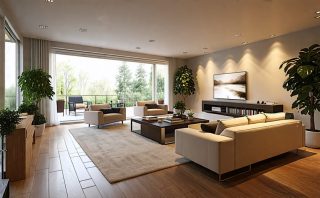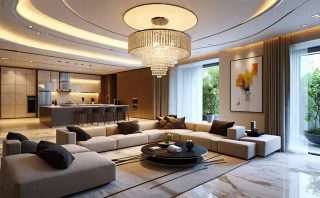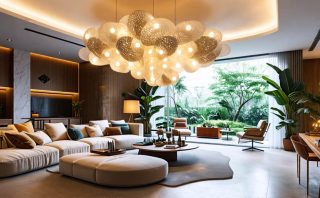Optimize your space by selecting appropriate lighting distribution. Utilize direct lighting to illuminate specific areas, enhancing task visibility and focus. Integrate indirect lighting to create ambient moods by bouncing light off ceilings or walls, which softens shadows and adds warmth. Embrace diffused lighting for an even spread, ideal for minimizing glare and creating cozy atmospheres. Implement accent lighting to highlight artwork or architectural elements, instantly drawing attention and adding drama. For flexibility, combine layered lighting with smart lighting systems, allowing you to adjust settings for various occasions or moods effortlessly. Each technique offers transformative possibilities, enabling precise control over your environment’s aesthetics and function.
Understanding Lighting Distribution
Lighting distribution is a crucial component of lighting design that refers to how light is spread or directed in a space. Understanding this concept allows you to create environments that are both functional and aesthetically pleasing, as it directly impacts the ambiance and usability of a room. Whether you’re a homeowner enhancing your living area or an architect designing commercial spaces, selecting the right type of lighting distribution is vital.
Often, there’s a misconception that brighter light equals better illumination, but effective lighting distribution focuses on the quality and direction of light. It considers factors like glare reduction and uniformity to ensure every part of a space is adequately lit without overwhelming. For instance, localized lighting can highlight specific features, while uniform lighting is ideal for workspaces. Integrating smart lighting solutions can further refine your control, offering tailored illumination options that enhance everyday living.
Incorporating human-centered design principles into lighting distribution ensures that the lighting serves the needs of its users, promoting well-being and efficiency. By grasping the nuances of lighting distribution, you enable yourself to make informed decisions that align with your aesthetic and functional goals, creating spaces that truly shine.
Type 1: Direct Lighting Distribution
Direct lighting distribution focuses light directly onto a surface or object, creating a concentrated and bright illumination. This type of lighting is ideal for highlighting specific areas or tasks, offering both functional and aesthetic benefits. Homeowners often utilize direct lighting in kitchens, where light focuses on countertops to enhance visibility for meal preparation. Additionally, pendant lights over dining tables serve both as focal points and provide necessary task lighting during meals.
For interior designers and architects, understanding the nuances of direct lighting can elevate the visual impact of a space. Direct lighting can emphasize architectural features such as exposed brick walls or artwork, casting deliberate shadows that add depth and texture to the room. Spotlights and track lighting are popular choices for these applications, allowing for adjustable and focused beams.
In commercial spaces, direct lighting plays a crucial role in enhancing productivity and showcasing products. For businesses like retail stores, direct lighting ensures that products are well-lit, drawing customers’ attention and creating an inviting atmosphere. Event planners also leverage direct lighting to accentuate key areas within a venue, such as stages or feature displays, ensuring they stand out.
When selecting fixtures for direct lighting, it’s important to consider factors like beam angle, fixture size, and bulb type to achieve the desired effect. LED solutions are particularly popular due to their energy efficiency and ability to produce bright, consistent light. Consulting with a lighting professional can provide tailored solutions, ensuring that the chosen lighting meets both functional needs and design preferences.
Overall, direct lighting distribution is a versatile tool for enhancing both residential and commercial spaces, offering precise control over lighting effects and creating an environment that is both functional and visually appealing. By strategically implementing direct lighting, any space can be transformed to meet specific goals and enhance user experience.
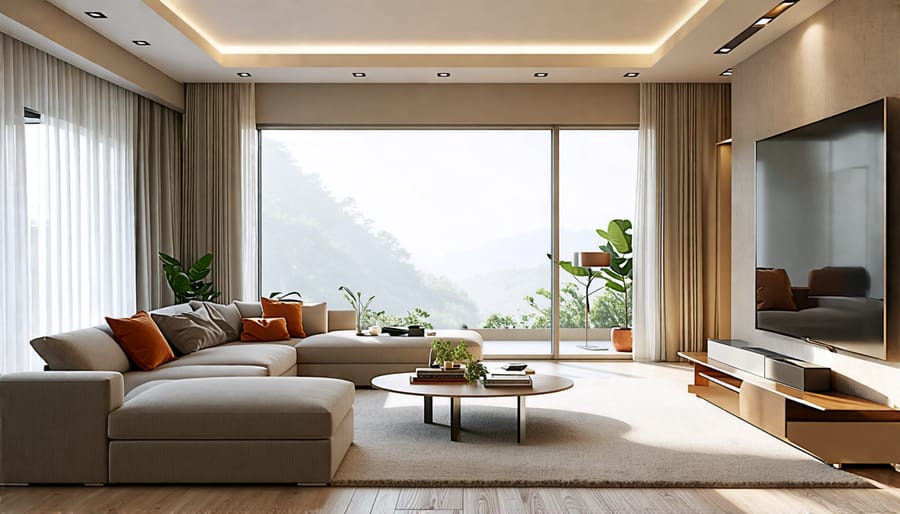
Type 2: Indirect Lighting Distribution
Indirect lighting distribution is an elegant lighting approach that elevates any space by casting illumination onto ceilings or walls rather than directly lighting a space. This technique creates a soft, ambient glow that enhances the aesthetic appeal of a room while minimizing shadows and glare. One of the significant advantages of indirect lighting is its ability to evenly distribute light, making spaces appear larger and more welcoming. This feature is especially beneficial in areas where comfort and atmosphere are paramount, like living rooms, restaurants, or hospitality venues.
In residential settings, indirect lighting can be subtly integrated into architectural elements like coves, valances, or hidden recesses, providing a gentle, sophisticated lighting effect. By bouncing light off surfaces, indirect lighting emphasizes the texture and color of walls, adding depth and interest without overpowering the room’s decor. For interior designers and architects, this flexibility in design allows for creativity while ensuring functional lighting.
In commercial spaces, indirect lighting plays a crucial role in setting the right tone. In offices, for instance, eliminating harsh shadows and glare can improve the working environment, leading to enhanced productivity and comfort. Furthermore, in retail spaces, the soft illumination helps create an inviting atmosphere that encourages customers to linger longer.
Event planners favor this lighting style for its ability to transform venues into elegant and inviting spaces. From weddings to corporate gatherings, the soft glow of indirect lighting adds a touch of sophistication and romance, highlighting key elements without detracting from the overall design theme.
Choosing the right fixtures for indirect lighting requires careful consideration of the space’s specific needs and architectural features. Consulting with a lighting professional can provide tailored solutions that maximize both aesthetic and functional benefits. Whether for residential, commercial, or event applications, indirect lighting is a versatile tool that enhances any space with its understated elegance and effective illumination.
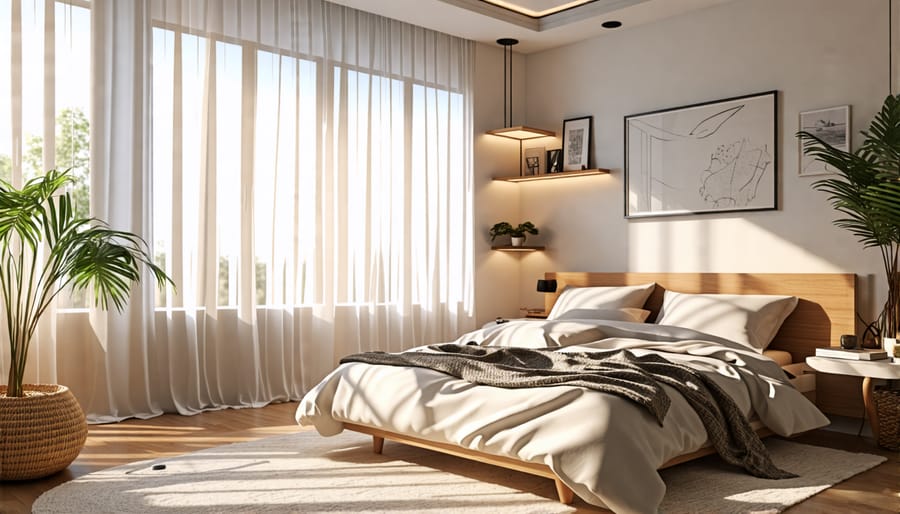
Type 3: Diffused Lighting Distribution
Diffused lighting is a popular choice in various settings due to its ability to evenly distribute light and minimize harsh shadows. This type of lighting works by scattering light through a medium, such as frosted glass or a fabric shade, which softens and spreads the light across a broader area. Unlike direct lighting, which focuses on a specific point, diffused lighting creates an ambient glow that envelops the space, making it ideal for settings where a warm and inviting atmosphere is desired.
In homes, diffused lighting is particularly effective in living rooms, dining areas, and bedrooms—spaces where comfort and relaxation are paramount. For interior designers and architects, incorporating diffused lighting can transform a stark room into a cozy retreat, highlighting furnishings and architectural details without overpowering them. It’s also a favorite in offices, where it reduces eye strain and provides a pleasant work environment, as well as in retail settings, where it enhances the shopping experience by creating a welcoming ambiance.
Event planners often use diffused lighting to set the mood for gatherings, weddings, and other celebrations, ensuring that guests feel comfortable and spaces look elegant. In commercial spaces, such as restaurants or hotels, diffused lighting adds an element of sophistication and warmth that can enhance customer satisfaction and encourage repeat visits. By understanding the unique benefits and applications of diffused lighting, homeowners and businesses can make informed decisions that not only improve aesthetics but also increase functionality and comfort within their environments.

Type 4: Semi-Direct Lighting Distribution
Semi-direct lighting distribution is a popular choice for those seeking a balance between ambient and focused illumination. This method directs approximately 60 to 90 percent of the light downward, while the remaining light is cast upward or outward, depending on the fixture design. This combination creates a warm and inviting atmosphere by reducing harsh shadows and minimizing glare, making it ideal for spaces like living rooms, dining areas, and open-plan offices where comfort and functionality are priorities.
One of the unique features of semi-direct lighting is its ability to highlight architectural elements and decorative details in a room. By offering both direct and indirect illumination, it enhances textures and surfaces, adding depth and interest to even the simplest designs. For homeowners and interior designers looking to create a harmonious visual environment, semi-direct lighting provides a subtle yet effective solution.
In commercial settings, such lighting can help reduce visual fatigue by distributing light evenly across workspaces, making it a practical option for offices and retail stores. Event planners may also find semi-direct fixtures beneficial for creating dynamic lighting effects that can transform a venue’s ambiance, bringing a touch of sophistication and elegance to weddings or corporate events.
When choosing semi-direct lighting, consulting with professionals can help tailor solutions to specific spatial needs and aesthetic preferences. This approach ensures that the lighting not only complements the decor but also fulfills functional requirements, providing an optimal blend of style and utility. By leveraging the benefits of this versatile distribution method, both residential and commercial spaces can achieve a harmonious balance of form and function.
Type 5: Semi-Indirect Lighting Distribution
Semi-indirect lighting distribution represents a harmonious balance between direct and indirect lighting, offering versatile illumination solutions across diverse settings. This type of lighting distribution is particularly beneficial in environments where a calm and inviting ambiance is desired, as it skillfully minimizes harsh shadows and glare. By directing approximately 60-90% of the light output towards ceilings and upper walls, semi-indirect fixtures softly diffuse light across a room, creating a welcoming environment ideal for both residential and commercial spaces.
To capitalize on the potential of semi-indirect lighting, start by carefully considering the architectural elements of the room. High ceilings and light-colored walls enhance the diffusion effect, allowing for a wider, more ambient glow. Pendant lights and sconces are popular choices for achieving this effect, seamlessly integrating functionality with aesthetic appeal. When paired with dimmable controls, these fixtures offer flexibility, allowing lighting levels to be adjusted to suit varying activities and moods.
Incorporating semi-indirect lighting into your design plan is an astute choice for enhancing social settings like living rooms, restaurants, or hotel lobbies where gentle illumination encourages relaxation and conversation. Additionally, aligning your choices with current lighting trends ensures your spaces remain both stylish and functional.
While implementing semi-indirect lighting, collaborating with lighting specialists can yield personalized solutions that align with your design aesthetics and functional needs. Expert guidance can further enhance the effect by balancing fixture placement and selecting complementary layers of light, resulting in a sophisticated lighting design that transforms spaces with subtlety and elegance.
Conclusion
In summary, understanding and applying the five types of lighting distribution—direct, indirect, diffused, task, and accent—can significantly enhance any space you design. Each type offers unique benefits: direct lighting provides focused illumination, ideal for workspaces; indirect lighting creates a soft, ambient atmosphere; diffused lighting spreads evenly for a balanced environment; task lighting focuses on functionality, perfect for specific activities; while accent lighting highlights features and adds visual interest.
By integrating different lighting distributions, homeowners, interior designers, architects, and business owners can craft environments that not only meet functional needs but also elevate the aesthetic appeal. When planning your next interior project, consider the mood and function each space requires, and select a combination of these lighting types to achieve your desired effect.
Our experts are here to help you navigate these choices, providing personalized advice and comparing high-quality products to suit your style and needs. Don’t underestimate the power of well-designed lighting to transform a room. Whether you’re revamping a cozy home space or designing a dynamic business setting, let informed lighting choices guide you to spectacular results.

